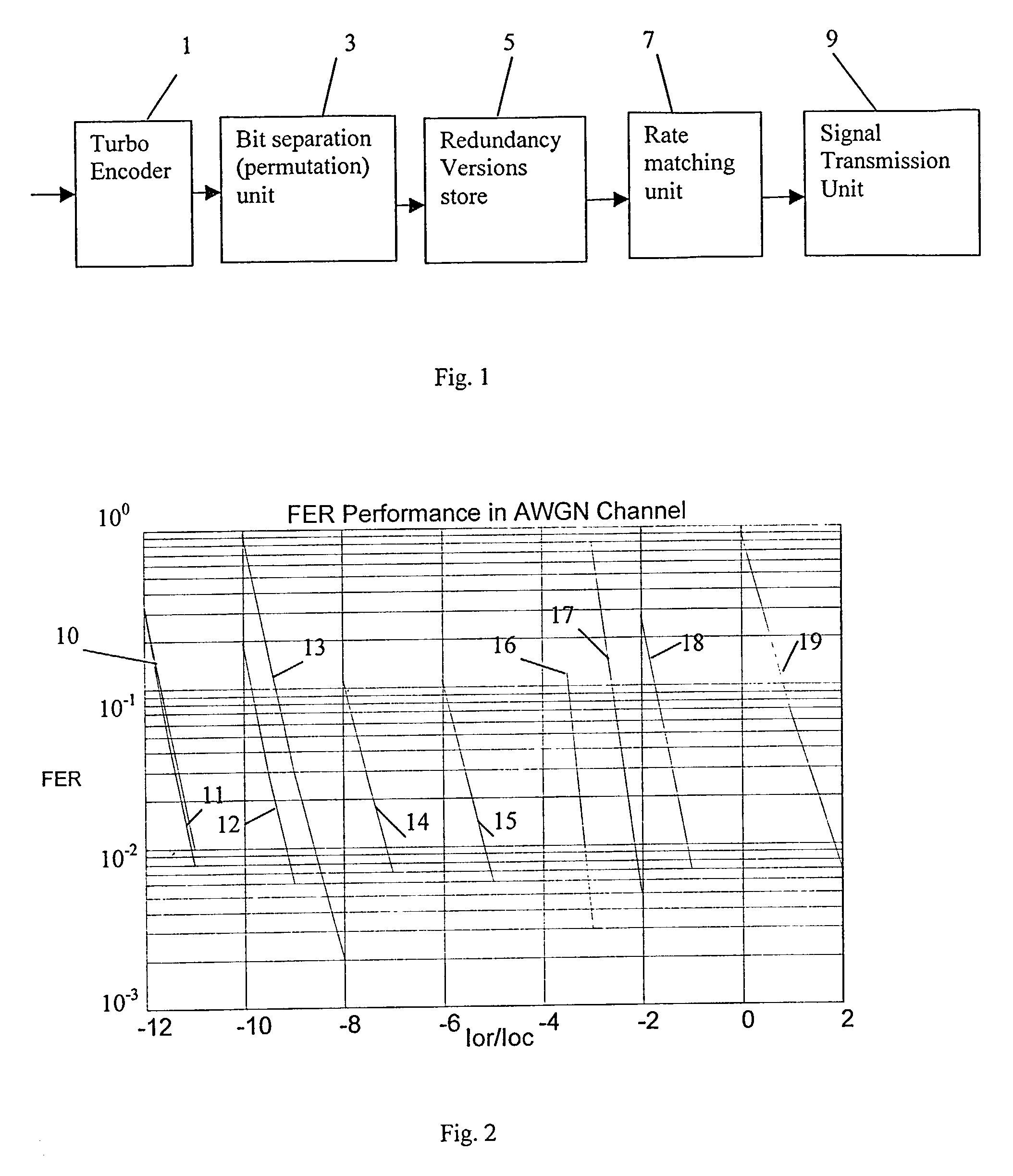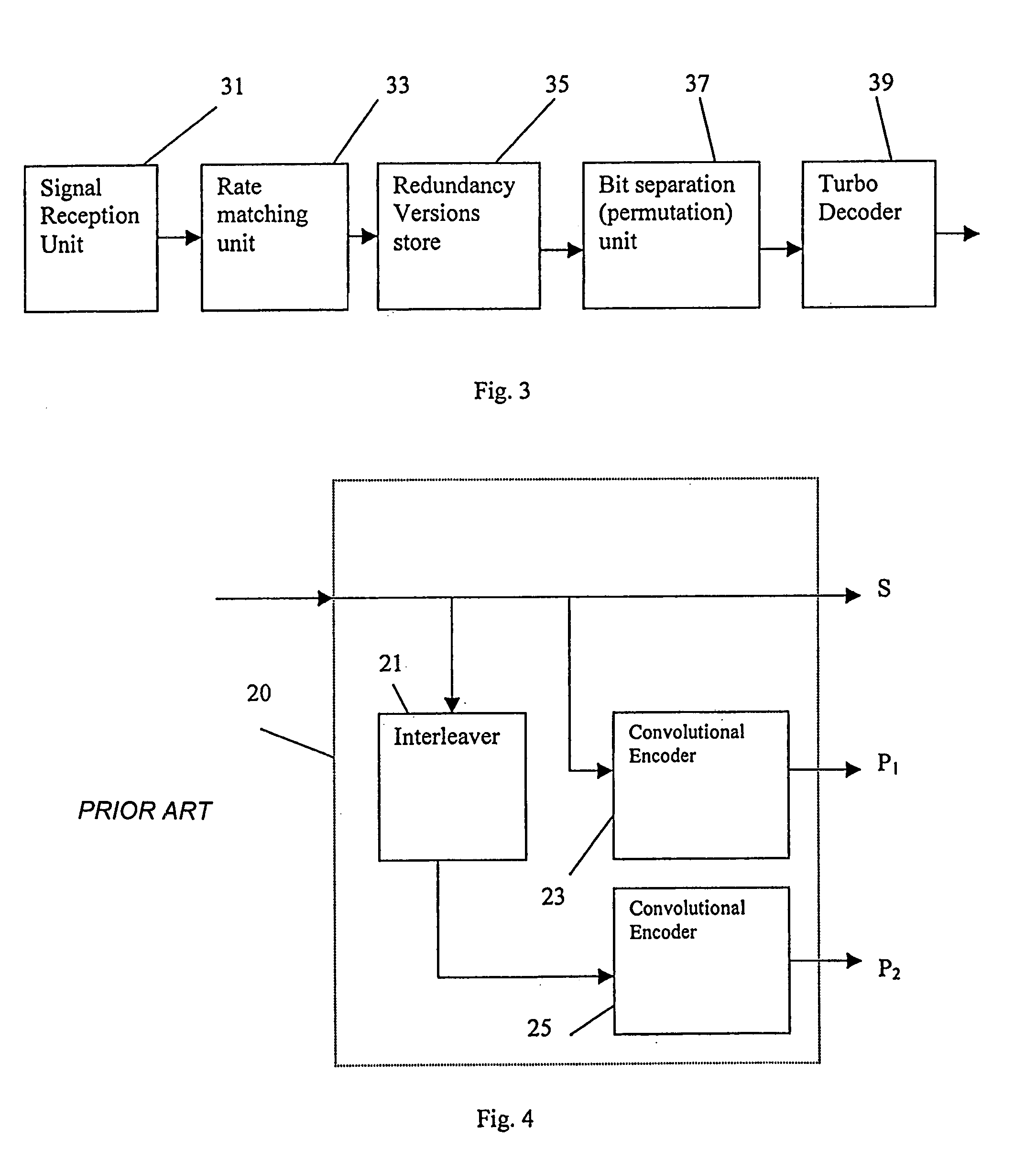Communication system employing turbo codes and a hybrid automatic repeat request scheme
- Summary
- Abstract
- Description
- Claims
- Application Information
AI Technical Summary
Benefits of technology
Problems solved by technology
Method used
Image
Examples
first embodiment
[0043]As the invention, consider a wideband code division multiple access (WCDMA) communication system using Turbo codes with coding rate of ⅓. Five modulation and coding schemes (MCS) are supported by this system. These are QPSK with coding rate of ¼, QPSK with coding rate of ½, QPSK with coding rate of ¾, 16QAM with coding rate of ½ and 16QAM with coding rate of ¾. Rate matching (puncturing or repetition) is employed to adjust the coding rates. As explained above with reference to FIG. 3, the output of the turbo encoder 1 is represented as (S, P1, P2). We refer to this encoded signal as “version 1”. The rate matching unit 5 is arranged, upon receiving this encoded signal to transmit the systematic bits and repeat or puncture the parity bits to get the desired coding.
[0044]Within the embodiment, the permutation unit 3 produces a further three redundancy versions:[0045]Version 2, (P1, P2, S). In this version, all the parity bits P1 will be transmitted and parity bits P2 and the syst...
second embodiment
[0062]The operation of the second embodiment is as follows:
[0063]As in the first embodiment, version 1 is initially transmitted from the redundancy version store 5 to the rate matching unit 7. The result is transmitted to the transmission unit 9 which produces a first transmission.
[0064]In the case that the receiver is performing Chase combining, if no acknowledgement (NACK) is received after the initial transmission, then the first version is sent again to the rate matching unit 7, and the result is retransmitted as a second transmission by the transmission unit 9. If NACK is received again, then the first version is sent again to the rate matching unit 7, and the result is retransmitted as a third transmission by the transmission unit 9.
[0065]By contrast, considering the case that IR in the receiver is desired, then following the first NACK, version 2 is transmitted to the rate matching unit 7, to produce a second transmission by the transmission unit 9. Following a further NACK, ...
third embodiment
[0067]We now turn to the invention. Again, the structure of the transmitter is as shown in FIG. 1, but in this case an encoder 1 is used having a coding rate of ⅕. Therefore, the output of Turbo encoder can be described as (S, P1, P2, P3, P4), where P3 and P4 are the two further parity bit streams. Suppose that the required coding rates for the transmissions are ¼, ½ and ⅓. Based on our invention, five IR redundancy versions can be constructed as follows:[0068]Version 1, (S, P1, P2, P3, P4). Upon receiving this version, the rate matching unit 7 is arranged to transmit all the systematic bits, and to puncture the parity bits P1, P2, P3, and P4 to get the desired coding rate for transmission;[0069]Version 2, (P1, P2, P3, P4, S). For this version, the rate matching unit 7 will arrange that all the parity bits P1 will be transmitted and parity bits P2, P3, P4 and the systematic bits S will be punctured to get the desired coding rate for transmission;[0070]Version 3, (P2, P3, P4, S, P1)....
PUM
 Login to View More
Login to View More Abstract
Description
Claims
Application Information
 Login to View More
Login to View More - R&D
- Intellectual Property
- Life Sciences
- Materials
- Tech Scout
- Unparalleled Data Quality
- Higher Quality Content
- 60% Fewer Hallucinations
Browse by: Latest US Patents, China's latest patents, Technical Efficacy Thesaurus, Application Domain, Technology Topic, Popular Technical Reports.
© 2025 PatSnap. All rights reserved.Legal|Privacy policy|Modern Slavery Act Transparency Statement|Sitemap|About US| Contact US: help@patsnap.com



